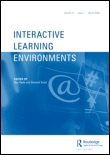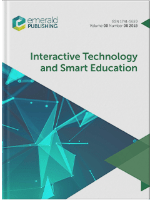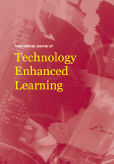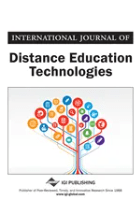
INTERACTIVE LEARNING ENVIRONMENTS
Scope & Guideline
Shaping the next generation of interactive educational practices.
Introduction
Aims and Scopes
- Interactive Learning Technologies:
The journal emphasizes the use of various interactive technologies, including virtual reality (VR), augmented reality (AR), and artificial intelligence (AI), to facilitate engaging learning experiences. - Pedagogical Innovations:
It explores new pedagogical strategies such as flipped classrooms, game-based learning, and collaborative learning to enhance student engagement and knowledge retention. - Diverse Learning Environments:
The scope includes formal, informal, and non-formal learning environments, addressing educational practices across different age groups and contexts. - Assessment and Evaluation:
The journal investigates innovative assessment methods and tools, including learning analytics and automated feedback systems, to measure learning effectiveness and improve educational practices. - Focus on Learning Outcomes:
Research on how interactive learning environments impact cognitive, emotional, and social outcomes for learners is a critical aspect of the journal's contributions.
Trending and Emerging
- Artificial Intelligence in Education:
A significant increase in publications exploring the role of AI, including chatbots and intelligent tutoring systems, in enhancing learning experiences and outcomes is evident. - Gamification and Game-Based Learning:
Research focusing on gamification strategies and serious games to boost engagement and motivation among learners has gained traction, reflecting a growing interest in playful learning. - Collaborative and Social Learning:
There is a rising emphasis on collaborative learning environments that leverage social interactions and peer feedback to enhance the learning experience. - Personalized Learning Experiences:
Emerging studies are increasingly addressing personalized learning pathways and adaptive learning technologies, showcasing the shift towards tailoring education to individual learner needs. - Integration of VR/AR Technologies:
The integration of VR and AR in educational settings is a trending topic, with research investigating their impact on experiential learning and student engagement.
Declining or Waning
- Traditional Instructional Methods:
There is a noticeable decrease in research focusing on conventional teaching methods without the integration of technology, as the emphasis shifts towards more interactive and technology-enhanced learning approaches. - General Theoretical Frameworks:
Papers centered on broad theoretical discussions without specific applications to interactive technologies or pedagogies have become less frequent, indicating a move towards more practical, application-based research. - Static Learning Environments:
Studies exploring static or non-interactive learning environments are less common, suggesting that the journal is prioritizing research that emphasizes interactivity and engagement. - Single-Discipline Focus:
Research that is limited to a single discipline or subject area is waning, as interdisciplinary approaches and the integration of technology across various fields gain more attention.
Similar Journals

Information Technologies and Learning Tools
Exploring the Future of Learning Through Information Technology.Information Technologies and Learning Tools is a pioneering scholarly journal dedicated to the exploration and dissemination of knowledge within the rapidly evolving field of educational technology. Published by the NATIONAL ACADEMY OF EDUCATIONAL SCIENCES OF UKRAINE, INSTITUTE OF DIGITALIZATION EDUCATION, this journal has maintained its Open Access policy since 2006, ensuring that groundbreaking research is readily available to educators, researchers, and practitioners worldwide. With the ISSN 2076-8184, the journal serves as a critical platform for innovative studies focusing on the integration of information technologies into educational practices, seeking to bridge gaps between digital tools and effective learning methodologies. Despite the absence of specific rankings, its commitment to advancing educational theories and applications positions it as an essential resource for professionals and students striving to enhance learning experiences through technology. As the educational landscape continues to transform, Information Technologies and Learning Tools stands at the forefront, fostering collaboration and knowledge sharing across diverse academic communities.

LANGUAGE LEARNING & TECHNOLOGY
Fostering Global Dialogue in Language Learning and TechLANGUAGE LEARNING & TECHNOLOGY, published by the University of Hawaii's National Foreign Language Resource Center, stands as a pioneering platform within the realms of linguistics, education, and computer science applications. With an impressive impact factor and esteemed rankings—achieving Q1 in Education and Q1 in Linguistics and Language—this open-access journal has been disseminating critical research since its inception in 1997. The journal operates under a commitment to fostering innovative approaches to language learning through technology, making it invaluable for researchers, educators, and practitioners seeking to enhance their understanding of this dynamic intersection. Hailing from the United States, the journal not only promotes scholarly dialogue but also champions accessibility to knowledge, ensuring that the latest advancements in language learning and technology are readily available to a global audience. With converged years documented from 1997 to 1998 and from 2000 to 2021, LANGUAGE LEARNING & TECHNOLOGY continues to play a pivotal role in shaping contemporary discussions around language education and the influence of technology on learning methodologies.

VIRTUAL REALITY
Exploring the Frontiers of Immersive TechnologyVIRTUAL REALITY is a prestigious journal published by SPRINGER LONDON LTD that has been at the forefront of the field since its inception in 1995. This journal, with an ISSN of 1359-4338 and E-ISSN 1434-9957, serves as an indispensable resource for researchers, professionals, and students interested in the rapidly evolving domains of computer graphics, human-computer interaction, and software development. VIRTUAL REALITY holds an impressive Q1 ranking across relevant categories, reflecting its high impact within the academic community, with specific rankings such as 11th overall in Computer Graphics and Computer-Aided Design and 31st in Human-Computer Interaction. This journal aims to publish cutting-edge research that explores theoretical advancements and practical applications related to virtual environments, contributing significantly to knowledge and innovation. With access options available through institutional subscriptions, it continues to shape the landscape of its field and inspire future research in immersive technologies.

Interactive Technology and Smart Education
Innovating education: where technology meets pedagogy.Interactive Technology and Smart Education is a leading academic journal published by EMERALD GROUP PUBLISHING LTD, dedicated to exploring the dynamic intersection of technology and education. With a robust impact factor signifying its significant contributions to the field, this journal consistently ranks in the Q1 quartile in categories such as Computer Science (Miscellaneous), Education, and E-learning, reflecting its prestige and wide-ranging influence. A staple for researchers, educators, and industry professionals, the journal addresses innovative practices and developments in interactive technologies that enhance teaching and learning experiences. Operating from its base in the United Kingdom, the journal spans nearly two decades of impactful publishing, featuring high-quality research that plays a crucial role in shaping the future of education through technology. Scholars seeking to stay at the forefront of this evolving field are encouraged to contribute and engage with the journal's pioneering work.

International Journal of Technology Enhanced Learning
Transforming Learning Experiences with Cutting-Edge TechnologyInternational Journal of Technology Enhanced Learning, published by INDERSCIENCE ENTERPRISES LTD, is a premier scholarly journal that comprehensively explores the intersection of technology and education, fostering innovative approaches to enhance learning processes. Established in 2008 and continuing through 2024, the journal is pivotal for researchers, educators, and technology professionals aiming to disseminate and engage with cutting-edge developments in technology-enhanced learning environments. With an admirable ranking in Scopus—placing in the 72nd percentile of Education and 49th in Computer Science Applications—the journal reflects a robust influence in the fields of Computer Science Applications and Education, as evidenced by its Q2 and Q3 quartile rankings. The journal not only provides a platform for empirical research and theoretical discourse but also emphasizes practical implementations in e-learning. Although it does not offer open access, its curated collection of articles serves as a vital resource for scholars and practitioners who are dedicated to advancing the nexus of technology and education.

Contemporary Educational Technology
Empowering Education Through TechnologyContemporary Educational Technology is a premier journal published by BASTAS PUBL LTD - UK, specializing in the dynamic intersection of educational practices and technological advancements. With an E-ISSN of 1309-517X, this journal serves as a vital resource for researchers, educators, and professionals keen to explore innovative solutions and methodologies in education. Ranked in the Q2 category for both Education and Management of Technology and Innovation in 2023, Contemporary Educational Technology boasts impressive Scopus ranks, standing at #187 out of 1543 in the Social Sciences Education field, reflecting its influence and contribution to contemporary research. Through its open-access approach, this journal facilitates the dissemination of knowledge, making cutting-edge research readily available to a global audience. By examining developments from 2018 through 2024, it aims to critically analyze and promote the integration of technology in educational contexts, thereby fostering improved learning outcomes and innovative teaching practices.

International Journal of Education and Information Technologies
Catalyzing Change in Educational Practices with TechnologyWelcome to the International Journal of Education and Information Technologies, a leading academic platform published by NORTH ATLANTIC UNIV UNION-NAUN. With an emphasis on the integration of education and information technology, this journal aims to foster innovative research and discussions that enhance pedagogical practices and technological advancements in educational contexts. Although currently an open access journal, it provides unrestricted access to emerging studies that are crucial for educators, researchers, and professionals aiming to stay at the forefront of education technology. While specific metrics such as H-index and Scopus ranks are yet to be defined, its ISSN 2074-1316 signifies its credibility and commitment to quality scholarship. This journal serves as a vital resource for those passionate about bridging the gap between technology and education, encouraging impactful research that shapes the future of learning environments.

Journal of Interactive Media in Education
Transforming Learning with Innovative TechnologyThe Journal of Interactive Media in Education, published by UBIQUITY PRESS LTD, stands as a prominent platform for scholars and practitioners interested in the integration of media and technology in educational contexts. With an impact factor reflective of its esteemed position—ranking in the Q1 category for Communication and Education, and Q2 for Computer Networks and Communications—this journal plays a critical role in advancing research that fosters innovative pedagogical approaches and enhances learner engagement. Established as an Open Access publication since 1996, it not only ensures wide dissemination of knowledge within the academic community but also promotes inclusivity and accessibility of educational research. With its scope ranging from interactive learning environments to the efficacy of digital resources, the journal publishes high-quality, peer-reviewed articles that contribute significantly to the fields of communication, education, and technology. Researchers, educators, and students will find this journal to be an invaluable resource for insights and developments in the dynamic field of interactive media.

Journal of Computers in Education
Empowering Education through Innovative Technology.The Journal of Computers in Education is a distinguished academic journal published by SPRINGER HEIDELBERG, dedicated to advancing the intersection of technology and pedagogy. With an ISSN of 2197-9987, this journal has established itself as a pivotal resource for researchers and educators alike since its inception in 2019, maintaining a strong focus on innovative applications of computer science within educational contexts. Ranked in the Q1 category in both Computer Science Applications and Education, the journal demonstrates a high impact in its field, holding a remarkable position within the top 1.5% of journals in social sciences (rank #20/1543) and top 5.5% in computer science applications (rank #45/817). The journal's scope encompasses a wide range of topics including but not limited to educational technologies, e-learning methodologies, and the effective integration of computers in teaching, making it an essential source for professionals and students who are keen to explore cutting-edge research and trends. Although access options vary, the journal's commitment to disseminating quality research continues to enrich the academic landscape in Germany and beyond, nurturing the synergies between education and technology.

International Journal of Distance Education Technologies
Elevating Distance Learning with Cutting-Edge ResearchInternational Journal of Distance Education Technologies is a premier scholarly publication, serving as a vital resource for researchers, educators, and technology professionals focused on the evolving field of distance education. Established in 2003 and published by IGI Global, this journal addresses the intersection of educational methodologies and technological advancements, contributing significantly to knowledge in areas including e-learning, computer networks, and education sciences. With notable rankings in the 2023 quartiles, it stands out at Q1 in Education and Q2 in categories such as Computer Networks and Communications and E-learning, reflecting its influence and reach within the academic community. This journal not only provides a platform for high-quality research but also engages with contemporary issues in technology-enhanced learning, making it indispensable for anyone striving to understand and innovate in distance education. Although it does not feature Open Access options, the journal’s rigorous peer-review process ensures that each published article offers valuable insights and relevant findings in this rapidly evolving domain.